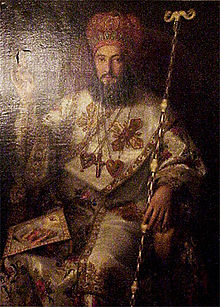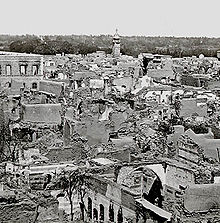Gregor Ata
Gregor Ata ( Arabic غريغوريوس عطا; also Gregorios, Gregorius, Gregoire, Gregorio or Gregory Ata ; Baptismal name Michael Ata ; * April 14, 1815 in Zahlé , Lebanon ; † December 3, 1899 in Damascus ) was an archbishop of the Melkite Greek Catholic Church of Homs in Syria , church historian and collector of ancient manuscripts. He visited Europe 1860–61 and advertised a. a. in Bavaria (Dioceses of Augsburg, Würzburg and Speyer) for alms for the Eastern Christians. Ata took part in the First Vatican Council as a council father in 1870 .
Life
Early work
The prelate was born under the name Michael Ata to Melkite Catholic parents in Zahlé , Lebanon. It is the third largest metropolis in Lebanon , a Christian stronghold and famous in the Middle East as the “City of Wine and Poets”.
Ata aspired to the spiritual profession, was ordained a priest and in 1848 was promoted to Oikonomus of the Patriarchate of Antioch in Damascus. Maximos III served as patriarch at this time . Mazloum (1833–1855) a learned, worldly experienced man who had spent almost 20 years in European exile and under whom the Melkite Church prospered strongly. Michael Ata was ordained a priest by him in 1837 and, as the patriarchate's economist, belonged to its curia and to his personal circle.
archbishop
Already on February 20, 1849 Ata received episcopal ordination from the hand of the patriarch and was appointed archbishop of the newly founded Melkite diocese "Homs, Hama and Yabrud" . With the episcopal ordination he took on the first name "Gregor". In addition to his pastoral duties, the archbishop collected ancient manuscripts and, as a church historian, researched the history of Christians in the Orient, especially the Melkite Catholics.
Trip to europe
When anti-Christian unrest raged in his homeland in 1860, in which around 30,000 believers were killed and many churches and monasteries were plundered or burned down, his diocese was one of the hardest hit. Among the murdered were three bishops and over 30 priests as well as the Franciscan Engelbert Kolland , who was later beatified . Thanks to the outstanding help of the Arab leader Abd el-Kader , many Christians were saved and calm was restored. The previously flourishing Christian communities were completely devastated. Ata was in Damascus when the unrest broke out on July 9, 1860 and only barely escaped death. Under the protection of Abd el-Kader, he came to Beirut with other Christians . Since an immediate return to Syria was impossible, the archbishop and other oriental clergy decided to take an action that was still unusual at the time. They went to distant Europe to collect urgently needed funds for the rebuilding of Christian life in their homeland. At the end of 1860 Gregor Ata stayed in Vienna and in 1861 he visited the Kingdom of Bavaria with the same intention . King Maximilian II assigned him the dioceses of Augsburg , Würzburg and Speyer .
The Viennese professor Friedrich Müller reported in 1898 in the "Melanges" for Charlez de Harlez, Liège canon and professor of oriental studies at the Catholic University of Leuven, about his earlier meeting with Archbishop Ata:
“ When Metropolitan Gregorius Ata lived in the local Dominican monastery for a long time in 1859/60 after the blood bath in Damascus , I became acquainted with him through the mediation of a higher cleric. The venerable gentleman, who understood no language other than Arabic, asked me to help him create a short Arabic-German vocabulary. "
In the diocese of Speyer , Vicar General Johann Martin Foliot issued a circular to all parish offices on February 15, 1861 under the serial number 349. In it the then sad situation of Christians in the Middle East is described again and it goes on to say:
" ... let us inform all pastors and pastors of our diocese that the Greek-uniied Archbishop of Homs and Hamah in Syria, Gregorius Ata, will arrive in Speyer in the next few days and will visit a number of parishes in our diocese from here to collect charitable gifts for the persecuted Christians. Several priests and bishops of Syria have now arrived in our Bavarian fatherland and have received permission from the King's Majesty to personally approach the various parts of the country for support. The revered Archbishop Gregorius Ata, in whose parish the sword and fire of persecution raged, the parishes of Augsburg, Würzburg and Speyer have been assigned "
In the letter, the clergy of the diocese are also called upon to give the oriental prelate "advice and deeds" . 18 stations are listed as visiting places of Atas in the diocese of Speyer, namely: Speyer , Schifferstadt , Frankenthal , Forst , Deidesheim , Neustadt , Kaiserslautern , Landstuhl , St. Ingbert , Blieskastel , Zweibrücken , Maikammer , Edesheim , Landau , Herxheim , Rheinzabern , Rülzheim and Germersheim .
From January 15, 1861 Archbishop Ata lived in St. Stephan Abbey , Augsburg . On May 25, 1861, he celebrated a divine service in his Byzantine liturgy in St. Burkard zu Würzburg, and on June 16, via Mainz , he arrived at Bishop Nikolaus von Weis in Speyer, where he also had a Byzantine service the next day, in the cathedral Mass celebrated.
The Speyer diocesan schema from 1864 reported on pages 182/183 looking back on the visit of the Syrian prince of the church:
“ In 1861 the Christians in Syria, who had been hard-pressed and robbed by their enemies, found considerable sympathy and had to avail themselves of the charity of their fellow believers in order to meet their church needs. The Most Revered Archbishop Ata von Damascus, who for this purpose personally, as in all of Bavaria, also in the diocese of Speyer, raised a collect for his unhappy diocese members, was delighted with abundant gifts of love in the most important places of the diocese visited by him in the most friendly welcome also received the sum of 1311 guilders from donations sent directly to the episcopal authority. "
Gregor Ata was apparently able to return home with a very large amount of donation and the entire company also proved the economic efficiency of the former economist of his church province.
In the treatise "The legal relationships of the various rites within the Catholic Church" (Archive for Catholic Church Law, Volume 7, Page 339, Mainz 1864), Professor Josef Hergenröther from Würzburg, the later cardinal, states that he met Archbishop Ata on the occasion of his stay in Bayern held an interview to which he owed "some interesting notes".
Gregor Ata's visit to the Diocese of Augsburg also recorded that he gave the historical association there an old Turkish silver coin.
Late years
In 1870 Archbishop Gregor Ata took part in the First Vatican Council as a council father , where he belonged to the minority who voted against the dogma of infallibility .
Gregor Ata ruled his archbishopric for 50 years, until his death in 1899, he was succeeded by Archbishop Flaviano Khoury . Ata resided in Yabrud for the past few years and died in Damascus. In 1886 the priest Sylwanos Mansour (1854–1929) served as his secretary; later he emigrated to Australia, where he became known nationwide as a Melkite chief chaplain.
Post fame
Gregor Ata was regarded as a profound expert on the history of the oriental church and wrote several works on it. In the History of Christian Arabic Literature by Georg Graf, 1953, it is said that Archbishop Ata left behind a number of writings, only parts of which were later published. He was a “great book lover” “and collected many manuscripts, the greater number of which were scattered after his death”; part of the Atas collection is still in Yabroud. Archimandrite and church historian Yusuf Nasrallah (1911–1993) used these and Ata's writings in 1937 as source material for his treatise "Manuscrits melkites des Yabroud".
literature
- Georg Graf: History of Christian Arabic Literature , Edition 146, Biblioteca Apostolica Vaticana, 1953, page 288.
- Friedrich Müller : "The origin of the Indian script", in: Melanges de Charlez de Harlez , Catholic University of Löwen, 1898, pages 217/218.
- Diocesan Schematism Speyer, 1864, pages 182 and 183.
Web links
- batta .html Entry on Gregorio (Michael) Ata (Atta) on catholic-hierarchy.org
- "Muslim massacre of Christians in Damascus" , Banner of Liberty , Middletown, NY, August 22, 1860 (English)
Individual evidence
- ^ Website of the city of Zahle in Lebanon
- ^ Entry to To the ecclesiastical office of the Oikonomus or economists on order online
- ^ Frédéric Pichon, Bernard Heyberger: Maaloula (XIXe-XXIe siècles): Du vieux avec du neuf: Histoire et identité d'un village chrétien de Syrie , Presses de l'Ifpo, 2011, ISBN 2351593200 , section 21, without page indication ; (Digital scan, French)
- ↑ Website on the Melkite-Catholic diocese (= eparchy) of Homs, Hama and Yabrud, with mention of Gregor Ata ( memento from April 19, 2012 in the Internet Archive )
- ↑ History of Christian Arabic Literature, Volume 2, 1953, on Bishop Ata's career
- ↑ Augsburger Sonntagsblatt , No. 5 of February 3, 1861, pp. 33–35 of the year; (Digital scan: Archbishop Ata's report on his experiences)
- ↑ Joseph Hergenröther on Archbishop Ata's visit to Bavaria (footnotes at the end of pages 338 and 339)
- ↑ Scan of the section about Archbishop Ata's stay in Vienna, from the "Melanges de Charles de Harlez", pages 217/218 (at the bottom of the displayed page)
- ↑ Augsburger Tagblatt No. 16, from January 16, 1861, p. 130 of the year; (Digital scan)
- ↑ Würzburger Anzeiger , No. 142, of May 24, 1861; (Digital scan)
- ↑ Pfälzer Zeitung , Speyer, No. 142, from June 20, 1861; (Digital scan)
- ↑ Annual report of the Historical Association for Swabia and Neuburg 1860 (page 53, bottom)
- ↑ Scan of the death report with death date
- ↑ Website about Sylwanos Mansour, in the online edition of the "Australian Dictionary of Biography" (mentioning Archbishop Ata)
| personal data | |
|---|---|
| SURNAME | Ata, Gregor |
| ALTERNATIVE NAMES | Ata, Gregorius; Ata, Gregorios; Ata, Gregoire; Ata, Gregory; Ata, Gregorio |
| BRIEF DESCRIPTION | Melkite Catholic Archbishop in Syria, Council Father I. Vatican |
| DATE OF BIRTH | April 14, 1815 |
| PLACE OF BIRTH | Zahlé , Lebanon |
| DATE OF DEATH | December 3, 1899 |
| Place of death | Damascus |


